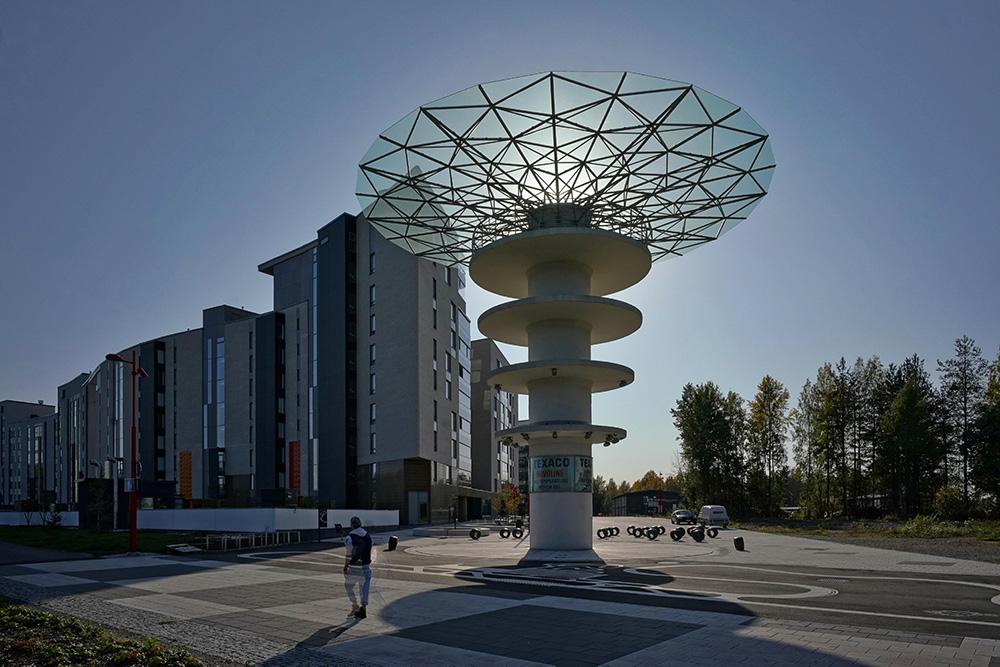TEMPERED GLASS
Lasiliiri’s Arctic Glass -Tempered ™ is made of heat-tempered glass. When broken, it crumbles into small crumbs. Tempered glass withstands shock, bending and temperature differences many times more than untempered glass.
The uses of tempered glass are e.g. doors, shop windows, balcony glass and interior glass such as tables and shelves. Tempered glass is used in glass structures where the glass may be exposed to large temperature fluctuations. Tempered glass is a natural choice for glass and double facades or as the top glass for photocell glazing.
Glass Lily manufactures Arctic Glass -Tempered ™ glass in the same facilities as Arctic Glass® insulating glass, so combining them into insulating glass is efficient and time-friendly.
Use of safety glass
The regulations and instructions concerning personal safety can be found in Part F2 of the Finnish Building Code, Building Safety. Regulations and instructions 2001. In the event of collisions and breakage of glass walls, windows, glass doors and railings in driveways and living areas, cuts must be prevented.
Any breakage of the glass roofs, skylights and glass roofs must not result in injury. To minimize this risk, it is possible to use thermally toughened safety glass on a case-by-case basis.
The Finnish Flat Glass Association has issued instructions and recommendations on the use of safety glass in relation to Part F2 of the Building Regulations. In addition to this, Lasiliiri also recommends the use of safety glass in furniture and interior design solutions.
Edge grinding
Laminated glass can also be supplied cut to size with various edge grindings. Grinding can be done on the glass either throughout or in selected combinations.
Tempered glass is always delivered at least sharp-edged (TSH). Other commonly used grinders are rough edge and gloss edge grinding (RRH and KRH).
The glass grinder performs grinding with a state-of-the-art double grinder that achieves excellent dimensional accuracy, even on large glass surfaces. The grinding line has an integrated drill.
The CNC machining center can be used e.g. the most common hinge machining and holes as well as point fastening systems for double facade structures. The machinery of the glass lab also enables grinding on coated special glass used in facades.
Glass machining
The machining of tempered and laminated glass is quite freely selectable, taking into account the sizing recommendations.
There are several sizing recommendations for machining, holes and notches, e.g. RT-38-10901 (Building glass, flat glass). Lasiliiri examines the feasibility of machining on a case-by-case basis. Ask more about our sales.
Various shape grinding and machining are made by CNili grinding of Lasiliiri directly using CAD files.
Dimensions of toughened glass
Most glass grades are temperable. In the case of patterned glasses, their hardenability must be ensured. Some coated sunscreen and energy saving glasses are also temperable.
Possibilities of inspected glass
- Minimum size 100 x 250 mm
- Maximum size 2400 x 4800 mm
- Thicknesses 3… 15 mm, both clear and mass dyed.
In addition to being coated, the glass can also be machined.
The possibilities of Arctic Glass Tempered ™ glasses are really versatile. The grinding and machining line can handle glass sheets of various sizes up to 2600 x 4600 mm. The maximum size of the delivered glass is 2500 x 4600 mm.
Any machining and shape cutting is always done before hardening.
Arctic Glass Tempered ™ is a thermally toughened safety glass and complies with the SFS-EN 12150-1 standard.
– The sound insulation properties of Arctic Glass® insulation glass meet the desired needs. In the manufacturing process, it is possible to use the joining of two glass sheets with a sound separation intermediate film (lamination). In this case, the sound insulation capacity is excellent.
In insulating glass, the sound insulation properties can be improved by changing the glass itself and / or the spacing of the glass. The number of intermediate layers and the thickness of the glass also affect the insulating properties.
Photos: Helsinki-Vantaa, south wing.
HARDENED LAMINATED GLASS
Combining the two types of safety glass, tempered glass and laminated glass, gives the best safety glass structure, which simultaneously achieves the mechanical resistance of tempered safety glass, resistance to temperature differences and bending strength, as well as shrinkage, UV protection, burglary resistance and sound insulation of laminated safety glass.
Good hardening line and modern EVA lamination guarantee the best adhesion with glass and film. In addition, the optical quality is top notch.
The glass safety combination glass is used in places where special structural strength and protection properties as well as excellent moisture resistance without delamination are sought.
Features:
- When broken, tempered laminated safety glass binds the fragments with a laminating film and thus does not pose a risk of personal injury and provides e.g. weather protection.
- Good mechanical and flexural breaking strength of tempered glass
- Durability of temperature differences
- The UV protection properties, sound insulation and numerous different color options provided by the lamination film.
Where to use:
Items that require special safety and strength, as well as items where the glass may be subjected to a wide range of stresses.
- Handrail glazing, stairs and partitions in public spaces.
- Elevators
- Glazing for sports facilities
- Floor glazing, stair treads
Clean lamination room and automatic conveyor
Positioning of laminated glass in a clean room
Advanced Pujol FAST CURING PUJOL 100 oven











